From enslavement to freedom: Five young girls from Antigua.
By Nigel Pocock, MPhil
Director, Vision Training & Research
Part 1: The Story of Leonora Casey Carr (1808-1837)
This is the unexpected story of five girls, all contemporary with each other, all from Antigua, and all, except one, manumitted from slavery in that island. All were at the Moravian School in East Tytherton, near Chippenham, Wiltshire. One of them, Leonora Carr, is buried there.
(Below) : The Georgian part of the Moravian burial ground. Leonora is probably buried in the far distance, to the right of the two trees in the picture on the left.
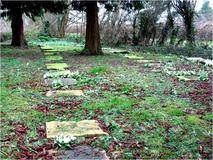
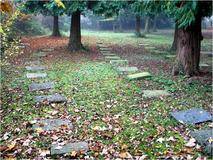
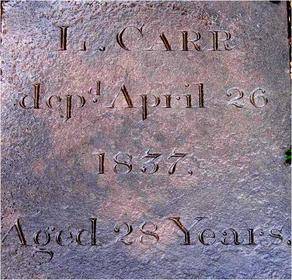
(Below) : The Moravian Burial Records show that Leonora died immediately after the Housekeeper of the Moravian School, Welsh woman Diana Ormond. Both were 'Single Sisters' (S. Sr.), which indicates that they resided in the Moravian Settlement . . .

(Below) The Moravian School and Sisters' House c. 1920 or earlier
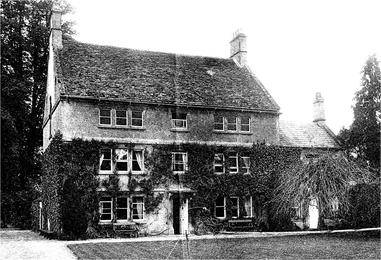
(Below) : The earliest extant photograph of the Moravian church, c. 1870, perhaps within 25 years of Leonora's death?
(Courtesy: The late Joan Archard)
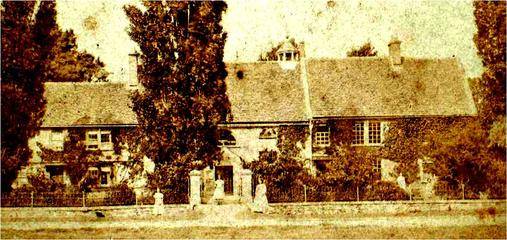
What then is her story?
Leonora Carr (1808-1837) was the daughter of planter George Carr, and a mulatto slave, Fanny Loving. Although she was born one year after abolition of the slave trade in British dominions, slavery itself was not abolished. This meant that Leonora followed the status of the mother. Fanny Loving was a slave, therefore Leonora must be one, too - and her siblings. For Leonora had one younger sister, Catherine, and two older brothers, Stephen, and the eldest, Edward. While we are not certain of their birth dates, they are usually placed in this order, which is probably following the convention of chronological order. Aged about 9 years, Leonora comes to England in February 1817, together with '2 other ladies and a young gentleman', to view the Moravian School. However, it was not to be for another three years that Leonora became a student at the Moravian Girls' School in East Tytherton. In the extract she seems to have considerable status, the connection with 'General Carr' being mentioned very specifically. The 'young gentleman' is not even named. During this time at the School, Leonora evidently progressed to the extent that she was received officially as a Moravian, undergoing the various rites of passage, such as taking communion, all of which the Moravians took very seriously and did not grant lightly. Apart from one incident where 19 year old Leonora was mentioned along with a group of girls taking food from the larder, we hear nothing about her time as a student.
(Below) : Moravian Reception Records tell us when Leonora was born . . .
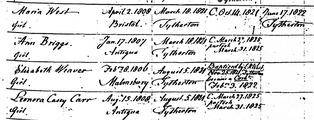
(Below) : . . . and that she was the natural daughter of George Carr . . .

(Below) : On 12th Feb. 1817, Leonora visits the Moravian school, before she was manumitted in April of the same year :

(Below) : The Moravian Congregational Diary tells us about Leonora's surreptitious adventures …
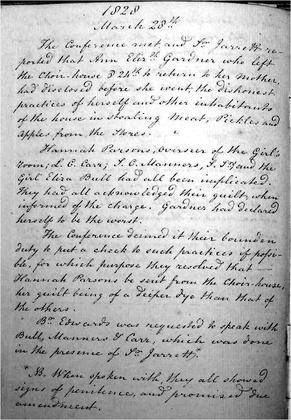
What we present next is highly speculative, and awaits confirmation. We know nothing definite about George Carr or Fanny Loving. It is highly likely that George Carr was a 'general' in the Antiguan militia. This organisation was the laughing stock of the regular troops. For it was completely top-heavy with officers, since all those with social pretensions would not serve without a rank they felt fitted their station in life. Hence, as historian Brian Dyde notes, the officers held bogus colonelcies and other senior ranks. The Moravians probably took it that he was a 'real' general (in the regular army), with genuine status. After all, Waterloo was only two years earlier. As it was, 'general' Carr was likely to have been pretty much a fake.
* * * * * *
And Fanny Loving? There are two possibilities, the first an extremely long shot. In the Foundling Hospital Archives there is a baptismal record for a Fanny Loving in 1772. This young girl is indentured to house painter William Cooke, at 20, Chapel Street, Hanover Square (near Oxford Circus and New Bond Street). Fanny's (presumably seven year) apprenticeship began at age 14 in 1786, so would been completed in 1791. Could Fanny have gone to Antigua as a free woman? Only to then become enslaved, illegally, being sold to Eliza Buckley Ledeatt for use on her plantations? The second possibility, and a more probable one, is a biological connection to the famous (or infamous, depending on one's affiliation) mixed-race newspaper proprietor, Henry Loving (1790-1850), editor of the Weekly Register. Loving is not a common name in Antigua, which must encourage the probability of a biological connection, and they are near contemporaries. Could Fanny have been Henry Loving's sister, cousin, or even his mother? We do not know.
(Below) : The very last name is that of Frances Loving. It is the record of the St. Pancras Foundling Hospital for 1772. Could this be Leonora's mother? Outcast because she was mixed race? Sent to the West Indies on pretext, legal or illegal? Frances would have been young enough to have had Leonora (Fanny then about 36 years old). (National Archives).
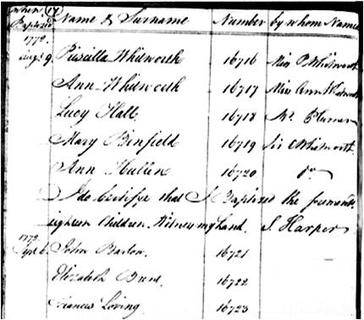
As regards Fanny's daughter, Leonora Casey Carr, we are on firmer ground, but still dealing with probabilities. For children to be named for an esteemed friend or relation, perhaps due to stipulations in a will, was not at all unusual. Could Leonora Casey Carr have been named for Leonora Hankinson Casey, a slightly older contemporary? Both 'Leonora' and 'Casey' are highly uncommon names in Antigua, and must invite the probability that there is a definite connection, this being too much of a coincidence. Leonora H. Casey married John Lindsay in 1819. The Lindsay family, 'general' George Carr, and the Casey family all reside in the St. George Parish in northern Antigua. Coincidence? Probably not. Leonora H. Casey herself may have lived in the southern parish of St. Paul's (or had a dwelling there), since she has a slave, Francis Livingston, who is named there. Is it another 'coincidence' that Eliza Buckley Ledeatt, Leonora C. Carr's purported 'owner' (until 1817) also had a plantation in St. Paul's (the only one in the Slave Registers), where Fanny Loving and her daughter Leonora C. Carr might have lived? And the web of connections does not end here, as the figure (below) shows. This figure is based on the genogram technique, which attempts to show how significant others are related to each person in the figure (Nancy Boyd-Franklin, 2003, Black Families in Therapy, London, Guilford Press, 236-7); it is not a family tree, per se:
(Below) : Genogram for Leonora Carr, showing some of her possible significant relationships :
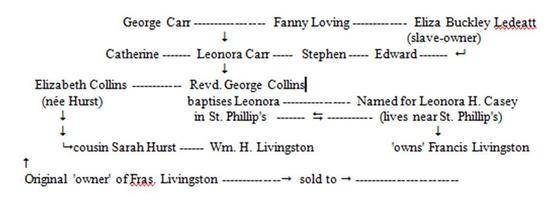
As can be seen from this genogram, the number of family and other relationships is intricate and probably quite close.
(Below) : In the Slave Registers, Leonora H. Casey 'owns' Francis Livingston :

In 1813, Leonora C. Carr, then aged about five years, is purchased from Eliza B. Ledeatt (27th November, 1813), sent to England (where she is 17th February, 1817), and manumitted (1st April, 1817), aged nine years. Leonora was therefore still a slave when sent to England. We know nothing about Leonora's life in the Moravian settlement, except that she stayed in the settlement as a 'single sister', travelled extensively within the locality to places such as Bath and Bristol (where there were other Moravian communities), and died aged 28 years, perhaps of tuberculosis. Unfortunately the Moravian Congregation Diary for these crucial years is missing. She was contemporary with other Antiguan slave women who were manumitted, and must have known them very well.
In one fascinating aside, Leonora's brother is named Edward Colston Carr. Edward Colston (1636-1721) was a member of the Bristol Merchant Venturers, a body much implicated in slavery-related investments. It appears almost certain that the Carrs were related to the Colstons, since Robert Carr is referred to as a 'cousin' and is an executor of Edward Colston's Will. Two of the Carr women were beneficiaries. So, while Edward Colston had no known children (he never married), this is nonetheless a close family connection. Does this lie behind the name 'Edward Colston Carr'? It is possible that Edward Colston, who was deputy governor of the Royal African Company whose main interest was in the slave trade, was himself related to a slave.
(Below) : The purchase of Leonora and her female family, makes it abundantly clear that the offspring of the women are being declared to be property in perpetuity (National Archives, Antigua).

(Below) : George Carr's manumission of Leonora Casey Carr and her brother, Edward Colston Carr (National Archives, Antigua).
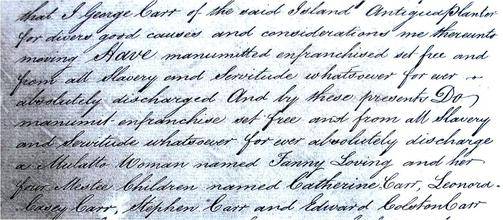
Leonora's gravestone and probable resting place, with flowers laid by the Transformations Black History Archive Team
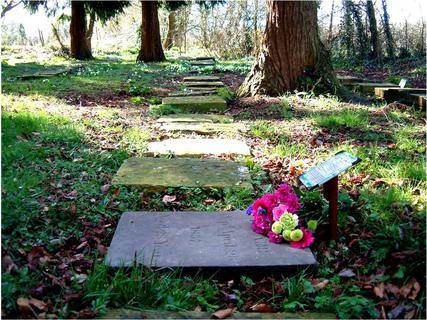
 Close
Close


